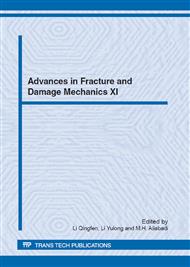p.5
p.9
p.13
p.17
p.21
p.25
p.29
p.33
p.37
Nondestructive Evaluation of Polyurethane Materials Using Transient Thermography
Abstract:
The aim of this work is to investigate the potential of transient thermography in the nondestructive evaluation of structural defects of NECURON 1001 using the FLIR thermographic system. Necuron is a polyurethane material used for applications like: fixture and gauges, master and copy models, models with high mechanical stress, etc. Transient thermography is a thermographic method which implies the investigation of materials that are of a different (often higher) temperature than the ambient. The heat flow into the sample is altered in the presence of a subsurface defect or feature, creating a temperature contrast at the surface that is recorded by the infrared system. Results show that this method of evaluation can indicate, in necuron, defects of small sizes that can be overlooked in the manufacturing process. Also, it was shown that the transient thermography method presented can be an important tool in evaluating structural defects of materials.
Info:
Periodical:
Pages:
21-24
Citation:
Online since:
November 2012
Keywords:
Price:
Сopyright:
© 2013 Trans Tech Publications Ltd. All Rights Reserved
Share:
Citation:


